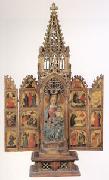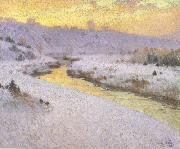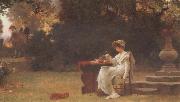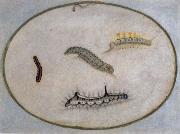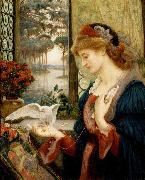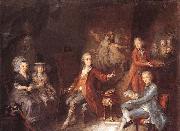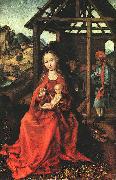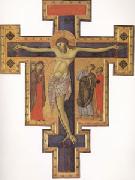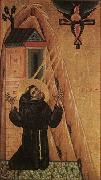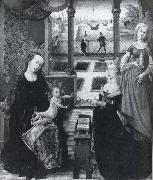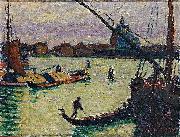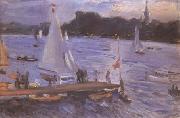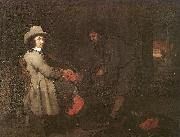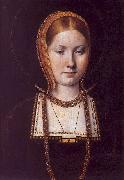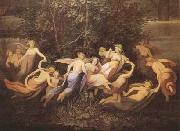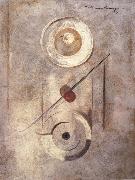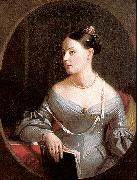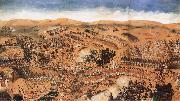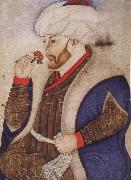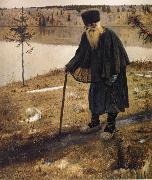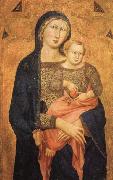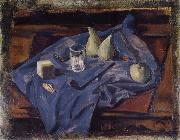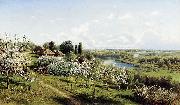|
|
|
|
|
|
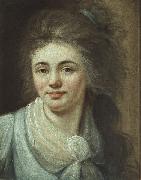 |
Ludovike Simanowiz
|
|
Deutsch: Friedrich Schiller (1759 - 1805), Ölgemälde von Ludovike Simanowiz 1793/94
English: Friedrich Schiller, German poet, philosopher, historian, and dramatist |
|
|
|
|
|
|
|
|
|
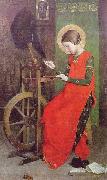 |
Marianne Stokes
|
|
(1855 Graz, Styria - August 1927 London), born Marianne Preindlsberger in the Austrian province of Styria, was an Austrian painter. She settled in England after her marriage to Adrian Scott Stokes (1854-1935), the landscape painter, whom she had met in Pont-Aven. Marianne Stokes was considered one of the leading artists in Victorian England.
Preindlsberger first studied in Munich under Lindenschmidt and having been awarded a scholarship for her first picture, 'Muttergluck', she worked in France under Pascal Adolphe Jean Dagnan-Bouveret (1852-1929), Colin and Gustave Courtois (1853-1923). She painted in the countryside and Paris, and, as with many other young painters, fell under the spell of the rustic naturalist Jules Bastien-Lepage. Her style continued to show his influence even when her subject matter changed from rustic to medieval romantic and biblical. While in France she met the Finnish painter Helene Schjerfbeck, in whose company she visited Pont-Aven in 1883.
Her first salon painting, 'Reflection', which had been painted in Brittany, was exhibited in 1885 at the Royal Academy. Her work was also shown at the Grosvenor Gallery, New Gallery, and the Society of British Artists and in 1885, a year after her marriage, she took to using the name 'Mrs. Adrian Stokes'. She held a joint exhibition with her husband at the Fine Art Society in 1900. The Stokes' lived in St Ives where Marianne was a member of the Newlyn School. Having no children, they regularly travelled abroad, frequently to the Tyrol, and in 1905 to Slovakia and the High Tatra. Here they spent about half a year sketching and painting in the villages of Važec, Mengusovce and Ždiar. Adrian Stokes concentrated on landscapes with images of hay-harvesting and picturesque cottages, while Marianne Stokes painted portraits showing fine detail of the garments. These paintings provide a valuable record of the Slovak culture.
After abandoning oils, and inspired by the Pre-Raphaelite movement, she painted flat compositions in tempera and gesso, her paintings giving the impression of being frescoes on plaster surfaces. She was an Associate of the Royal Society of Painters in Water Colours.
|
|
|
|
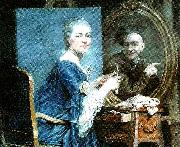 |
marie suzanne giroust roslin
|
|
Marie-Suzanne Giroust, född 9 mars 1734 i Paris, Frankrike, död 31 augusti 1772 i Paris, var en fransk konstnär, i huvudsak verksam inom pastellmåleri. Hon var gift med den svenske porträttmålaren Alexander Roslin från 1759 till sin död.
Dotter till Barthelemy Giroust och Marie Suzanne Leroy. När Giroust var sju år gammal, dog hennes far som var juvelerare. Fyra år senare dog även hennes mor, och hon flyttade in hos släktingar. Arvet efter fadern gav henne möjlighet att uppta målarstudier. Hon inledde sina studier hos Maurice Quentin de La Tour, men det var hos Joseph-Marie Vien hon kom att finna sig tillrätta. I Viens atelj?? träffade hon 1752 Alexander Roslin och blev förälskad. Girousts förmyndare kunde dock inte acceptera den svenske målaren som blivande make, då han var fattig och protestant.[1] Paret kämpade för sin kärlek, och Giroust vägrade att träffa de friare som hennes förmyndare föreslog för henne.[1] Efter medling av bland andra Roslins vän och beskyddare, Comte de Caylus, kunde Roslin och Giroust gifta sig, den 5 januari 1759. Paret Roslin fick mellan 1760 och 1772 sex barn, tre döttrar och tre söner, varav två döttrar och två söner nådde vuxen ålder.
Alexander Roslin erkände offentligen sin hustrus talang som konstnär, och han hävdade att hon var en skickligare pastellmålare än han själv. Giroust invaldes 1770 i den franska konstakademin, Acad??mie royale. 1771 utställde hon sitt porträtt av abb?? Lemonnier, som fick mycket beröm. Hon måladet i pastell.
Marie-Suzanne Giroust avled i bröstcancer i slutet av augusti 1772. |
|
 |
Marmion, Simon
|
|
French-born Flemish Northern Renaissance Painter, ca.1425-1489 |
|
 |
Martin Archer Shee
|
|
RA (December 23, 1769 - August 13, 1850) was a British portrait painter and president of the Royal Academy.
He was born in Dublin, of an old Catholic Irish family, and his father, a merchant, regarded the profession of a painter as an unsuitable occupation for a descendant of the Shees. Martin Shee nevertheless studied art in the Dublin Society, and came to London. There, in 1788, he was introduced by William Burke to Joshua Reynolds, on whose advice he studied in the schools of the Royal Academy. In 1789 he exhibited his first two pictures, the "Head of an Old Man" and "Portrait of a Gentleman." Over the next ten years he steadily increased in practice. He was chosen an associate of the Royal Academy in 1798, in 1789 he married, and in 1800 he was elected a Royal Academician. He moved to George Romney's former house in Cavendish Square, and set up as his successor.
Shee continued to paint with great readiness of hand and fertility of invention, although his portraits were eclipsed by more than one of his contemporaries, and especially by Thomas Lawrence. The earlier portraits of the artist are carefully finished, easy in action, with good drawing and excellent discrimination of character. They show an undue tendency to redness in the flesh painting defect which is still more apparent in his later works, in which the handling is less "square," crisp and forcible. In addition to his portraits he executed various subjects and historical works, such as Lavinia, Belisarius, his diploma picture "Prospero and Miranda", and the "Daughter of Jephthah."
In 1805 he published a poem consisting of Rhymes on Art, and a second part followed in 1809. Lord Byron spoke well of it in his English Bards and Scotch Reviewers. Shee published another small volume of verse in 1814, entitled The Commemoration of Sir Joshua Reynolds, and other Poems, but this was less successful. He also produced a tragedy, Alasco, set in Poland. The play was accepted at Covent Garden, but was refused a licence, on the grounds that it contained treasonable allusions, and Shee angrily resolved to make his appeal to the public. He carried out his threat in 1824, but Alasco was still on the list of unacted dramas in 1911. He also published two novels - "Oldcourt" (1829, in 3 volumes) and "Cecil Hyde" (1834). |
|
|
|
|
|
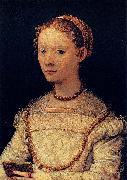 |
Maso da San Friano
|
|
(1536-1571) was an Italian painter active in Florence. His real name was Tomaso D'Antonio Manzuoli. He was born in San Friano and died in Florence.
According to Giorgio Vasari, Maso was a pupil of Pier Francesco Foschi while others claim it was Carlo Portelli. He collaborated with an elder Michelangelo on some projects.
His altarpiece of the Visitation was painted in 1560 for the church of San Pier Maggiore of Florence - now in Trinity Hall Chapel, Cambridge, England. A similar work can be seen in the Prato cathedral. After 1561, he painted in the church of Ognissanti, Florence and in the church of Santa Felicita. He participated in the decoration of the Studiolo of Francesco I with an oval canvas relating the Fall of Icarus story (1572). The canvas has an affected milling in individuals below and an anomalous perspective; both are classic features of mannerist painting. His second contribution Mining of Diamonds. A portrait of Ferdinando I de' Medici (1570) by Maso can be found in the Town Council Hall of Prato.
He is thought to be one of part of the Contra-Maniera or Counter-Mannerism movement in Florence. His most important pupils were Jacopo da Empoli and Alessandro Fei.
One of his paintings, thought to be of Cosimo I de Medici in 1560, is believed to be the oldest to show a watch
|
|
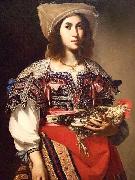 |
Massimo Stanzione
|
|
(also called Stanzioni; c. 1586 - c. 1656) was an Italian Baroque painter, mainly active in Naples.
Massimo Stanzione was an Italian Baroque painter. Born in Naples in 1586, Massimo was greatly influenced by Michelangelo Merisi da Caravaggio, but what earned him the nickname of The Neapolitan Guido Reni was his sophisticated and graceful style. The thing that distinguished Massimo art from Carravaggism was that he combined Caravaggio dramatically lit and brutally realistic style with the classical and lyrical manner of Bolognesi painters.
Though his preliminary training is uncertain, it is thought that he studied with Fabrizio Santafede; however, most of the influence he received was from Caravaggio. Art historians believe that Stanzione developed his career as an artist in Rome. It is thought that he bagan his career as a portraitist. Some of his most famous works include Portrait of a Woman in Popular Costume, and Portrait of Jerome Banks. Between 1617 and 1630, it is believed that he traveled between the papal city and his hometown of Naples exploring different styles of art. Also influenced by Caravaggio were Artemisia Gentileschi, Simon Vouet, and Carlo Saraceni. During Stanzione career a movement that changed the style of art was formed. Stanzione was a part of this movement. This movement transformed the dark, contrasted Caravaggio-styled art into Bolognese colorism and soft art.
|
|
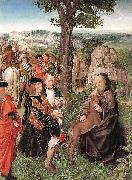 |
Master of Saint Giles
|
|
The Master of Saint Giles (French: Maître de Saint-Gilles) was a Franco-Flemish painter active, probably in Paris, about 1500, working in a delicate Late Gothic manner, with rendering of textures and light and faithful depictions of actual interiors that show his affinities with Netherlandish painting. It is not clear whether the Master of Saint Giles was a French painter who trained in the Low Countries (perhaps more likely), or a Netherlander who emigrated to France.
His pseudonym was given him by Max Friedländer, who reconstructed part of the anonymous painter's oeuvre, starting from two panels devoted to Saint Giles (a Miracle and a Mass) in the National Gallery, London, that were part of the lefthand shutter of an altarpiece, and two further panels now in Washington from the same altarpiece. The hand of an assistant can be discerned in the Baptism of Clovis at the National Gallery of Art, Washington, who also have a panel with Episodes from the Life of a Bishop-Saint - perhaps Saint Leu, Saint Denis or Saint Remy. All four panels have, or had, single grisaille figures of saints (Saints Peter, Giles, Denis and an unidentified bishop-saint) in niches, imitating sculpture, on the reverse. The Washington pair, which were in poor condition, have been separated and are lost, although photographs exist. Undoubtedly there were further panels, whose subjects cannot be guessed, as the combination of scenes is original. |
|
|
|
|
|
|
|
|
|
|
|
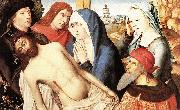 |
Master of the Legend of St. Lucy
|
|
(fl. 1480-1510) was an unidentified Early Netherlandish painter who worked in Bruges, now a city in Belgium. His name comes from for an altarpiece in the church of Saint James in Bruges, which is dated 1480 and depicts three scenes from the life of Saint Lucy. Since then, twenty-five to thirty-five paintings have been attributed to the same hand. He may have trained Spanish students at his studio in Bruges. Many of them are characterized by views of the city of Bruges in the background, and can be dated according to the level of construction of its belfry. He may have trained with Dieric Bouts, and was certainly influenced by Bruges' greatest artist at the time, Hans Memling.
|
|
|
|
|
|
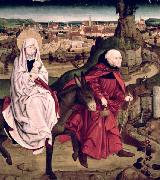 |
Master of the Schotten Altarpiece
|
|
was a German painter, active in Nuremberg during the 14th and 15th centuries. His name is derived from an altarpiece dated to about 1390, which once stood in the church of St. Mary in Schotten. The altarpiece was dismantled in 1828.
|
|
|
|
|
|
|
|
|
|
|
|
|
|
 |
Michel Sittow
|
|
(c.1469-1525) was a painter from Reval (now Tallinn, Estonia) who was trained in the tradition of Early Netherlandish painting. For most of his life, Sittow worked as a court portrait painter, for Isabella of Castille, the Habsburgs and others in Spain and the Netherlands. He was one of the most important Flemish painters of the era.
|
|
|
|
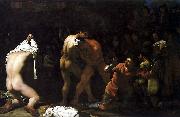 |
Michiel Sweerts
|
|
(29 September 1618-1664), also known as Michael Sweerts, was a Flemish painter of the Baroque period, active in Rome (1645-1656) in the style of the Bamboccianti. The Bamboccianti were known for depicting genre scenes of daily life, but Sweerts's contributions to this genre display greater stylistic mastery and social-philosophical sensitivity than many of his colleagues in this "school." Highly successful in Rome during his years there, Sweerts's reputation suffered a severe collapse not long after his death, lasting centuries; but thanks especially to the 2002 international monographic exhibition devoted entirely to him, Michael Sweerts: 1618-1664, he has begun once again to enjoy the esteem his work clearly merits.
Born in Brussels, he arrived in Rome in 1646, and rapidly moved into the circle of Flemish painters associated with Pieter van Laer (leader of the so-called Bamboccianti painters) and that resided near Santa Maria del Popolo. In 1647, he attended meetings of the Accademia di San Luca, although not as a member. Despite the fragmentary nature of evidence pertaining to his career in Rome and the post-mortem eclipse of his reputation, we know that Sweerts succeeded in creating for himself a sufficiently exalted reputation in the city so as to enter into the service of the ruling papal family itself, the Pamphilj, more specifically, Camillo Pamphilj, nephew of reigning Pope Innocent X who, at the encouragement of Camillo, bestowed upon Sweerts the papal title of Cavaliere di Cristo, the same honor enjoyed by the likes of Gian Lorenzo Bernini and Francesco Borromini. Despite working in the highest echelons of papal patronage in Rome, sometime between 1652 and 1654, for reasons unknown Sweerts left the Eternal City and returned to the North, and by 1656, he had returned to Brussels, where he joined the painter's guild. He joined the Paris Foreign Missions Society as a lay brother and became a devout Christian. In 1658 he made the guild a self portrait as a farewell gift and moved to Amsterdam, where he would oversee the building of a ship for travel with the aforementioned Missions Étrangeres to Palestine. |
|
|
|
|
|
|
|
|
|
|
|
|
|
|
|
|
|
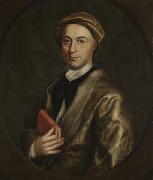 |
Nathaniel Smibert
|
|
(January 20, 1734 - November 8, 1756), was an artist in Boston, Massachusetts, in the mid-18th century. Born in Boston in 1734, he trained as a painter with his father, the artist John Smybert, and produced several portraits, notably of Ezra Stiles, architect Peter Harrison, and Dorothy Wendell (in the Collection of Dr John L Hale, Boston). |
|
|
|
|
|
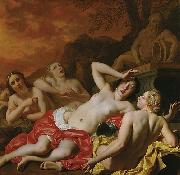 |
Nicolaes van Helt Stockade
|
|
(1614-1669), was a Dutch Golden Age painterAccording to Houbraken, Joost van den Vondel made a poem about him.
According to the RKD he became a master in the Antwerp Guild of Saint Luke in 1646 and worked on the city hall of Nijmegen and the Amsterdam City Hall.
|
|
|
|
|
|
|
|
|







